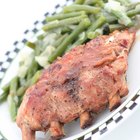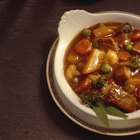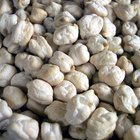
Make no bones about it -- it's a shame to waste those pricey prime rib bones. While a standing rib roast, another name for prime rib, looks impressive, get an extra meal out of the bones without a lot of extra work. The aromatic broth the ribs cook in is an added bonus. No prime rib bones? No problem. Rib-eye steak is a prime rib roast cut into steaks. Save the bones from rib-eye steaks and freeze them until you have enough to simmer.
Beefy Prime Rib Bones
Step 1
Cut the bones from the raw roast by sliding a sharp knife between the bone and the meat. Leave about an inch of meat attached to each bone.
Step 2
Preheat the oven to 450 degrees Fahrenheit. Place the bones in a single layer on a roasting pan. Roast for 15 to 20 minutes until the bones have browned a bit. This extra step removes a lot of fat from the ribs and adds flavor to the bones.
Step 3
Turn the slow cooker on high. Put the bones in the slow cooker along with any vegetables such as carrots and onions. Add herbs of your choice -- thyme, basil and sage all work well. Push down gently on the bones and vegetables to remove any extra space between the vegetables and bones.
Step 4
Pour enough liquid in the slow cooker to barely cover the bones and vegetables. Use beer, broth, vegetable juice or wine -- even water. Lower the heat from high to low when the liquid starts to simmer. The lower the heat the longer the ribs cook.
Step 5
Cook until the meat on the bones starts to fall away and the vegetables are soft, about five to six hours. The exact cooking time depends on your slow cooker.
Bones Smothered in Sauces
Step 1
Brown the ribs in the oven at 450 F for 15 to 20 minutes.
Step 2
Turn the slow cooker on low. Put the ribs in the slow cooker.
Step 3
Add enough barbecue, teriyaki, pizza or buffalo wing sauce to the slow cooker so that the sauce is 2 inches deep. Swirl the bones through the sauce. The sauce does not have to cover the bones.
Step 4
Cook for five to six hours until the meat is ready to fall off the bone.
Related Articles

How to Cook Beef Bones for Stock in the ...
How to Cook Pork Neckbones in a Slow ...

How to Cook Texas Broil Roast

How to Cook Bone-In Pork Strips in the ...

How to Cook Japanese Teppanyaki

How to Cook Pan Fried Deer Tenderloin

How to Cook Neck Bones & Pig Feet

How to Cook a Chuck Short Rib

How to Fix Too Much Italian Seasoning ...

How to Cook Boneless Country Spare Ribs

How Long Can You Cook Beef Ribs at 300 ...

How to Cook the Neck of a Deer

How to Cook Mixed Greens

How to Boil Celery

How to BBQ Ribs on a Smoker

How to Cook Beef Topside in a Slow ...

How to Cook a Neck Roast

How to Cook BBQ Rattlesnake

How to Bake Thin Sliced Turkey Cutlets

How to Cook Corned Silverside in a Slow ...
References
- Splendid Soups; James Peterson
- Food and Wine: Classic Pot au Feu
- The Art of Cooking: Arnold Zabert
- USDA Blog: Cooking Meat? Check the New Recommended Temperatures
Tips
- Strain the broth to remove the vegetables. Place the broth in a container. Cool to room temperature and then put in the refrigerator for a few hours. Skim off any fat. It will congeal at the top of the container. Return the broth to a clean slow cooker. Add assorted vegetables, barley, lentils and tomatoes for a hearty vegetable soup.
Warnings
- If the broth isn't simmering -- you see tiny bubbles coming to the surface -- ensure that the meat is at a minimum of 145 F, advises the U.S. Department of Agriculture.
- Don't leave bones from a cooked roast at room temperature for more than an hour.
Writer Bio
Katie Jensen's first book was published in 2000. Since then she has written additional books as well as screenplays, website content and e-books. Rosehill holds a Master of Business Administration from Arizona State University. Her articles specialize in business and personal finance. Her passion includes cooking, eating and writing about food.
Photo Credits
DC Productions/Photodisc/Getty Images